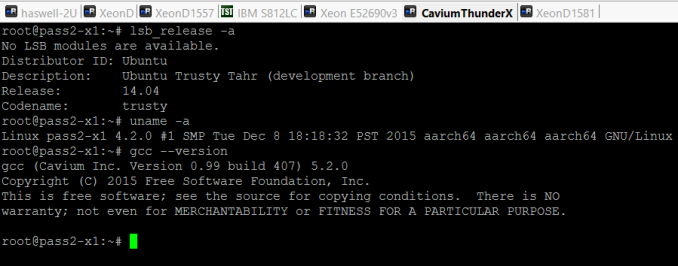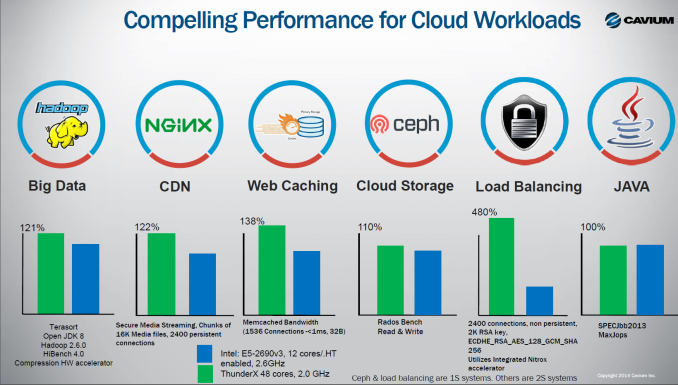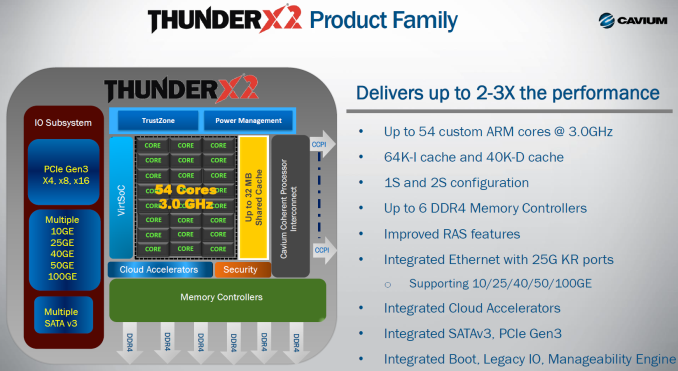Investigating Cavium's ThunderX: The First ARM Server SoC With Ambition
by Johan De Gelas on June 15, 2016 8:00 AM EST- Posted in
- SoCs
- IT Computing
- Enterprise
- Enterprise CPUs
- Microserver
- Cavium
Limitations of This Review
Before we get to our closing thoughts, I want to talk a bit about what we were and weren't able to do in our testing, and in what ways this limits our review. The still somewhat "rough on the edges" software ecosystem gave us a lot of headaches. Our setup was a Ubuntu 14.04 with lots of customized (Cavium's beta gcc compiler, MySQL version ThunderX 5.6) and newer software (the Linux kernel 4.2). The result was that we were slowed down by a large number of solvable (but time consuming) software and configuration problems.
Don't get me wrong: Linux on ARM has come a long way. Most software works, the exception was Spark 1.5 (Java based) which crashed with a very low level message. Still, it took quite a bit of time to get software configured correctly, while on x86 it is simply a matter of using "apt-get install".
Cavium told us that they expect that these problems will be solved in Ubuntu 16.04, and a firmware upgrade to support the new Ubuntu is on its way. That is also why we were not able to test our most real world and relevant benchmarks, such as our webserver tests. Webcaching, light webserving and Contend Delivery Networking might fit the ThunderX well as it has access to more memory and networking bandwidth than the Xeon D.
But webservers require a lot of software components (caching layer, webserver, interpreter etc.) that have to work together well. So we wait for 16.04 and the new firmware to arrive to build these complex tests.
Closing Thoughts
Exploring a new ambitious server SoC is always an interesting journey, but also a very time intensive one. We had to find out what the real performance profile of the ThunderX, not the perceived or advertised one. There have been both good and bad surprises in our journey.
Let's start with the bad: the blocking L1 cache, high latency L2-cache and high latency DRAM access are lowering the scalability of the 48 cores in a whole range of software. The ThunderX could still be a good candidate as front-end webserver, but Cavium has to solve the high power usage at low loads. Power management seems to be more problematic than single-threaded performance. Cavium promises that ThunderX2 will vastly improve power management by letting hardware handle much more of the management duties. But the current ThunderX power management capabilities seem to be rather basic. Cavium's information is sketchy at best.
The Xeon D, by comparison, offers superior performance per watt: twice as good as the ThunderX. It is clear that the ThunderX is not a good match for heavy database servers, nor for enterprise workloads where energy consumption at low load is a high priority.
The good. The 12 and 16-core Xeon Ds ($1300-$1800) and midrange E5s ($900-$2000, not including 10 GBe NICs) cost quite a bit more than the ThunderX ($800). Gigabyte could not tell us how much the R120-T30 would cost, only that the pricing would be "competitive with similar midrange Xeon E5 servers".
Although single-threaded performance is low, it is definitely not as terrible as commonly assumed. We found out that the raw integer computing power of the Thunder-X is about one-third that of the best Xeon Ds, not one-fifth as claimed in advertising materials (a difference of 65%). The ThunderX core is almost as good as the A57, while it consumes quite a bit less power and thus offers a better performance-per-watt than the latter. On the condition that you give it enough DRAM, the 48 cores are able to offer the Java performance of a midrange Xeon E5, even when we expect the system to remain under a certain response time.
Those facts – better than expected single threaded performance and midrange Xeon E5 throughput – make a world of difference. And we have yet to test the ThunderX in situations that is was really built for: network-intensive ones. The XML processing and h264 substests (SPEC CPU) indicate that there is definitely some truth in Cavium's claims that the ThunderX shines as a compute engine of a load balancer, web cache or CDN server.
As single threaded performance (SPEC CPU) is not as dramatic as commonly assumed and Java performance is already very close to what was promised, this puts the forthcoming ThunderX2 in a different light.
Using the new 14 nm FinFET technology of GlobalFoundries, Cavium claims it will reach 2.6-3.0 GHz and get a lot of microarchitectural improvements. This should result in twice as much performance per core. If indeed the ThunderX2 can offer single threaded performance at the level of the low end Xeon D (1.3-1.5 GHz), that might place it in the "SoCs with acceptable single threaded performance" and opens up new markets. Time will tell, but Cavium has proven it can deliver SoCs in a timely manner. And the fact that Cavium allows independent testing instead of just showing numbers on PowerPoint presentations tell us that they have confidence in the future of their ARMv8 endeavors.













82 Comments
View All Comments
vivs26 - Wednesday, June 15, 2016 - link
Not necessarily - (read Amdahl's law of diminishing returns). The performance actually depends on the workload. Having a million cores guarantees nothing in terms of performance unless the workload is parallelizable which in the real world is not as much as we think it could be. I'm curious to see how xeon merged with altera programmable fabric performs than ARM on a server.maxxbot - Wednesday, June 22, 2016 - link
Technically true but every generation that millstone gets a little smaller, the die area and power needed to translate x86 into uops isn't huge and reduces every generation.jardows2 - Wednesday, June 15, 2016 - link
Interesting. Faster in a few workloads where heavy use of multi-thread is important, but significantly slower in more single thread workloads. For server use, you don't always want parallelized tasks. The results are pretty much across the board for all the processors tested: If the ThunderX was slower, it was slower than all the Intel chips. If it were faster, it was faster than all but the highest end Intel Chips. With the price only being slightly lower than the cheapest Intel chip being sold, I don't think this is going to be a Xeon competitor at all, but will take a few niche applications where it can do better.With no significant energy savings, we should be looking forward to the ThunderX2 to see if it will bring this into a better alternative.
ddriver - Wednesday, June 15, 2016 - link
There is hardly a server workload where you don't get better throughput by throwing more cores and servers at it. Servers are NOT about parallelized task, but about concurrent tasks. That's why while desktops are still stuck at 8 cores, server chips come with 20 and more... Server workloads are usually very simple, it is just that there is a lot of them. They are so simple and take so little time it literally makes no sense parallelizing them.jardows2 - Wednesday, June 15, 2016 - link
In the scenario you described, the single-thread performance takes on even more importance, thus highlighting the advantage the Xeon's currently have in most server configurations.niva - Wednesday, June 15, 2016 - link
Not if the Xeon doesn't have enough cores to actually process 40+ singlethreaded tasks con-currently.hechacker1 - Wednesday, June 15, 2016 - link
But kernels and VMWare know how to schedule multiple threads on 1 core if it's not being fully utilized. Single threaded IPC can make up for not having as many cores. See the iPhone SoCs for another example.ddriver - Wednesday, June 15, 2016 - link
Not if you have thousands of concurrent workloads and only like 8 cores. As fast as each core might be, the overhead from workload context switching will eat it up.willis936 - Thursday, June 16, 2016 - link
Yeah if each task is not significantly longer than a context switch. Context switches are very fast, especially with processors with many sets of SMT registers per core.ddriver - Thursday, June 16, 2016 - link
If what you suggest is correct, then intel would not be investing chip TDP in more cores but higher clocks and better single threaded performance. Clearly this is not the case, as they are pushing 20 cores at the fairly modest 2.4 Ghz.